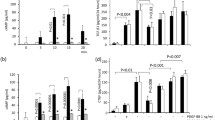Abstract
TGF-β plays a central role in the initiation and progression of pulmonary fibrosis. Glucocorticoids are frequently used to treat fibrotic diseases, but beneficial effects are often modest. Both TGF-β and glucocorticoids have been reported to increase fibroblast contraction of native collagen gels, a model of fibrotic tissue remodeling. Therefore, we sought to determine how glucocorticoids interact with TGF-β in this system. In this study, human fetal lung fibroblasts (HFL-1) were pretreated with or without TGF-β for 72 h before they were cast into type I collagen gels. Various concentrations of glucocorticoids (budesonide or hydrocortisone) were added at the time of casting. Gel size was then monitored at different times after gel release. The surrounding media were collected for the assay of prostaglandin E2 (PGE2) and the cell lysates were analyzed for cyclooxygenase (COX) expression by immunoblot. Glucocorticoids alone significantly enhanced fibroblast-mediated contraction of collagen gels (P < 0.01) and dose-dependently inhibited PGE2 release by HFL-1 fibroblasts. TGF-β significantly augmented gel contraction but also induced a 30% increase in PGE2 release and increased the expression of COX-1. Glucocorticoids inhibited TGF-β1 induced-PGE2 release, and enhanced TGF-β augmented gel contraction without significantly affecting TGF-β augmented COX-1 expression. Indomethacin, a COX inhibitor, increased TGF-β augmented gel contraction but had no further effect when added together with glucocorticoids. Thus, glucocorticoids can synergize with TGF-β in augmenting fibroblast mediated collagen gel contraction through the inhibition of PGE2 production. Such interactions between glucocorticoids and TGF-β may account, in part, for the lack of response of fibrotic diseases to glucocorticoids.
Similar content being viewed by others
References
Mio, T., Y. Adachi, D. J. Romberger, R. F. Ertl and S. I. Rennard 1996. Regulation of fibroblast proliferation in three dimensional collagen gel matrix. In Vitro Cell Deve. Biol. 32: 427–433.
Elsdale, T. and J. Bard. 1972. Collagen substrata for studies on cell behavior. J. Cell Biol. 54: 626–637.
Labarca, C. and K. Paigen. 1980. A simple, rapid and sensitive DNA assay procedure. Anal. Biochem. 102: 344–352.
Bergman, I. and R. Loxley. 1963. Two improved and simplified methods for the spectrophotometric determination of hydroxyproline. Anal Chem. 35: 1961–1965.
Laemmli, U. 1970. Cleavage of structural proteins during the assembly of the head of bacteriophage T4. Nature. 227: 680–685.
Tomasek, J. J., C. J. Haaksma, R. J. Eddy and M. B. Vaughan. 1992. Fibroblast contraction occurs on release of tension in attached collagen lattices: dependency on an organized actin cytoskeleton and serum. Anat. Rec. 232: 359–368.
Skold, C. M., X. Liu, Y. K. Zhu, T. Umino, K. Takigawa, Y. Ohkuni, R. F. Ertl, J. R. Spurzem, D. J. Romberger, R. Brattsand and S. I. Rennard. 1999. Glucocorticoids augment fibroblast mediated contraction of collagen gels by inhibition of endogenous PGE production. Proc. Assn. Am. Phys. 111: 249–258.
Coulomb, B., L. Dubertret, E. Bell and R. Touraine. 1984. The contractility of fibroblasts in a collagen lattice is reduced by corticosteroids. J. Invest. Derm. 82: 341–344.
Singer, A. J. and R. A. F. Clark. 1999. Cutaneous wound healing. N. Engl. J. Med. 341: 738–746.
Rennard, S. 1997. Pathophysiological mechanisms of COPD. Eur. Respir. Rev. 7: 206–210.
Rennard, S. I. 1999. Inflammation and repair processes in chronic obstructive pulmonary disease. Am. J. Respir. Crit. Care Med. 160: S12–S16.
Ehrlich, H. P. and D. J. Wyler. 1983. Fibroblast contraction of collagen lattices in vitro: Inhibition by chronic inflammatory cell mediators. J. Cell Phys. 116: 345–351.
Schalkwijk, C., M. Vervoordeldonk, J. Pfeilschifter, F. Marki and H. Van Den Bosch. 1991. Cytokine-and forskolin-induced syntehsis of group II phosphilipase A2 and prostaglandin E2 in rat mesangial cells is prevented by dexamethasone. Biochem. Biophys. Res. Commun. 180: 46–52.
Nakano, T., O. O., H. Teraoka and H. Arita. 1990. Glucocorticoids suppress group II phosphilipase A2 production by blocking mRNA synthesis and posttranscriptional expression. J. Biol. Chem. 265: 12745–12748.
Goulding, N. J., J. L. Godolphin and P. R. Sharland. 1990. Antiinflammatory lipocortin 1 production by peripheral leucocytes in response to hydrocortisone. Lancet. 335: 1416–1418.
Peers, S. H., F. Smillie, A. J. Elderfield and R. J. Flower. 1993. Glucocorticoid and non-glucocorticoid induction of lipocortins (annexins) 1 and 2 in rat peritoneal leucocytes in vivo. Br. J. Pharmacol. 108: 66–72.
Errasfa, M. and F. Russo-Marie. 1989. A purified lipocortin shares the anti-inflammatory effect of glucocorticosteroids in vivo in mice. Br. J. Pharmacol. 97: 1051–1058.
Solito, E., G. Raugei, M. Melli and L. Paretne. 1991. Dexamethasone induces the expression of the mRNA of lipocortin 1 and 2 and the release of lipocortin 1 and 5 in differentiated but not undifferentiated U-937 cells. FEBS Lett. 291: 238–244.
Liu, X. D., R. Ertl, C. M. Sköld, K. Takigawa, D. J. Romberger, J. R. Spurzem and S. I. Rennard. 1997. TGF-β pretreated human fetal lung fibroblasts possess enhanced ability to contract type I collagen gels. Am. J. Respir. Crit. Care Med. 155: A178.
Ziesche, R., E. Hofbauer, K. Wittmann, V. Petkov and L. H. Block. 1999. A preliminary study of long-term treatment with interferon gramma-1β and low-dose prednisolone in patients with idiopathic pulmonary fibrosis. N. Eng. J. Med. 341: 1264–1269.
Burke, C., C. K. Power, A. Norris, A. Condez, B. Schmekel and L. W. Poulter. 1992. Lung function and immunopathological changes after inhaled corticosteroid therapy in asthma. Eur. Respir. J. 5: 73–79.
Trigg, C. J., N. D. Manolitsas, J. Wang, M. A. Calderon, A. McAulay, S. E. Jordan, M. J. Herdman, N. Jhalli, J. M. Duddle, S. A. Hamilton, J. L. Devalia and R. J. Davies. 1994. Placebo-controlled immunopathologic study of four months of inhaled corticosteroids in asthma. Am. J. Respir. Crit. Care Med. 150: 17–22.
Laiinene, A., A. Altraja, M. Kämpe, M. Linden, I. Virtanen and L. A. Laitinene. 1997. Tenascin is increased in airway basement membrane of asthmatics and decreased by an inhaled steroid. Am. J. Respir. Crit. Care Med. 156: 951–958.
Author information
Authors and Affiliations
Rights and permissions
About this article
Cite this article
Wen, FQ., Sköld, C.M., Liu, XD. et al. Glucocorticoids and TGF-β1 Synergize in Augmenting Fibroblast Mediated Contraction of Collagen Gels. Inflammation 25, 109–117 (2001). https://doi.org/10.1023/A:1007170622699
Issue Date:
DOI: https://doi.org/10.1023/A:1007170622699




